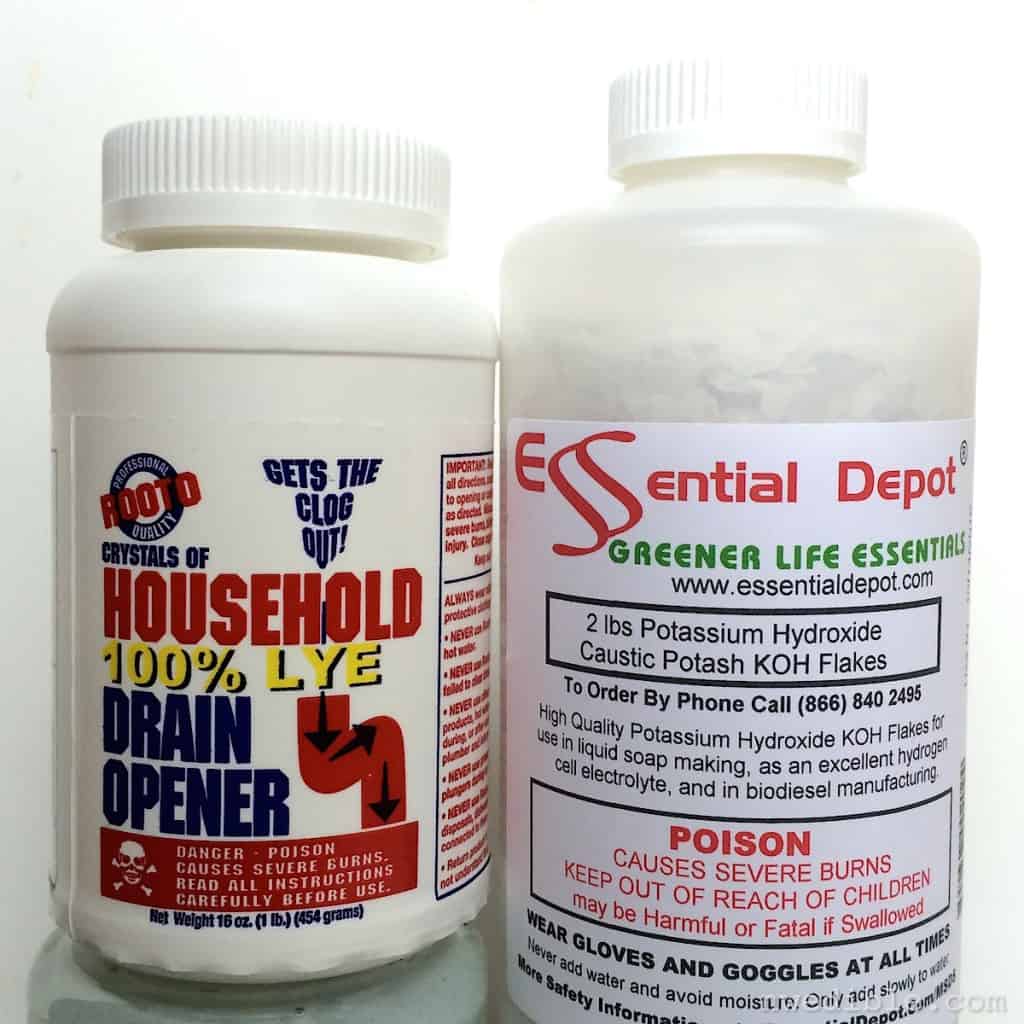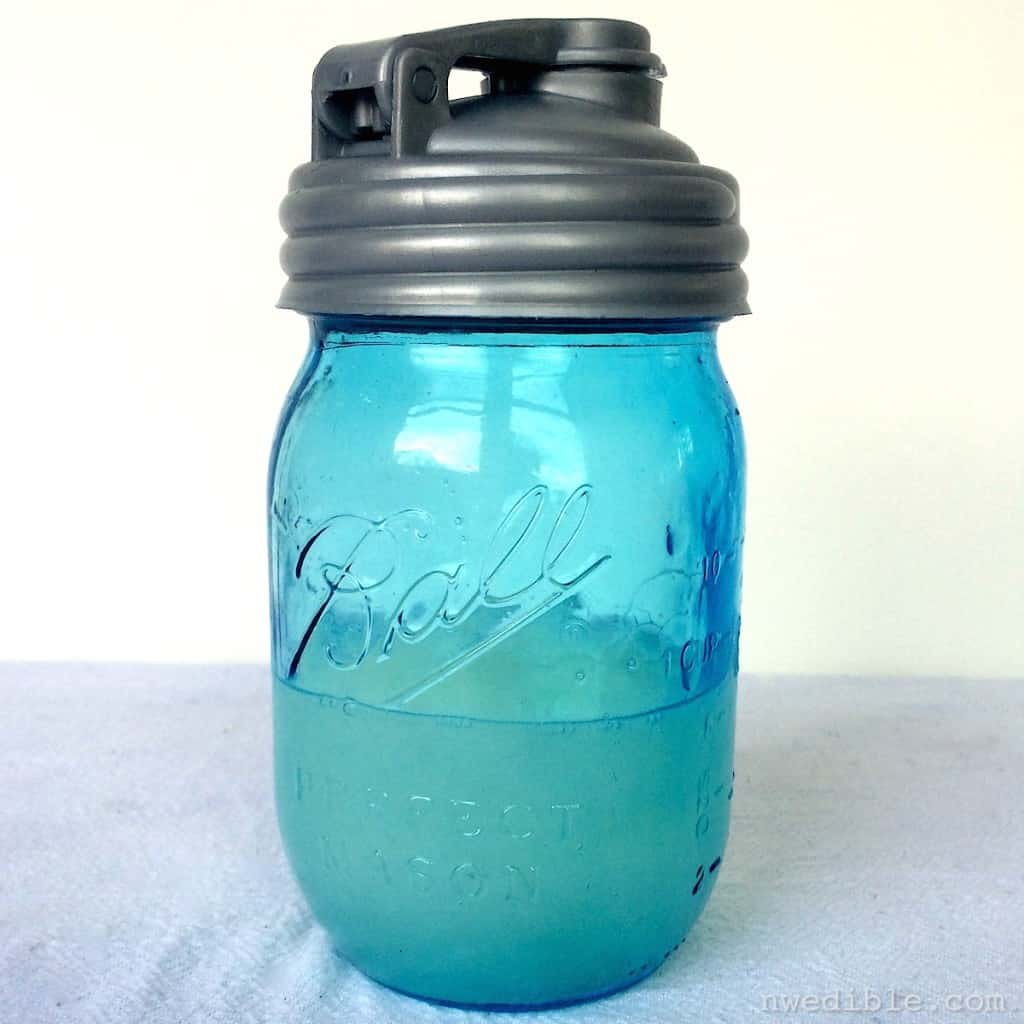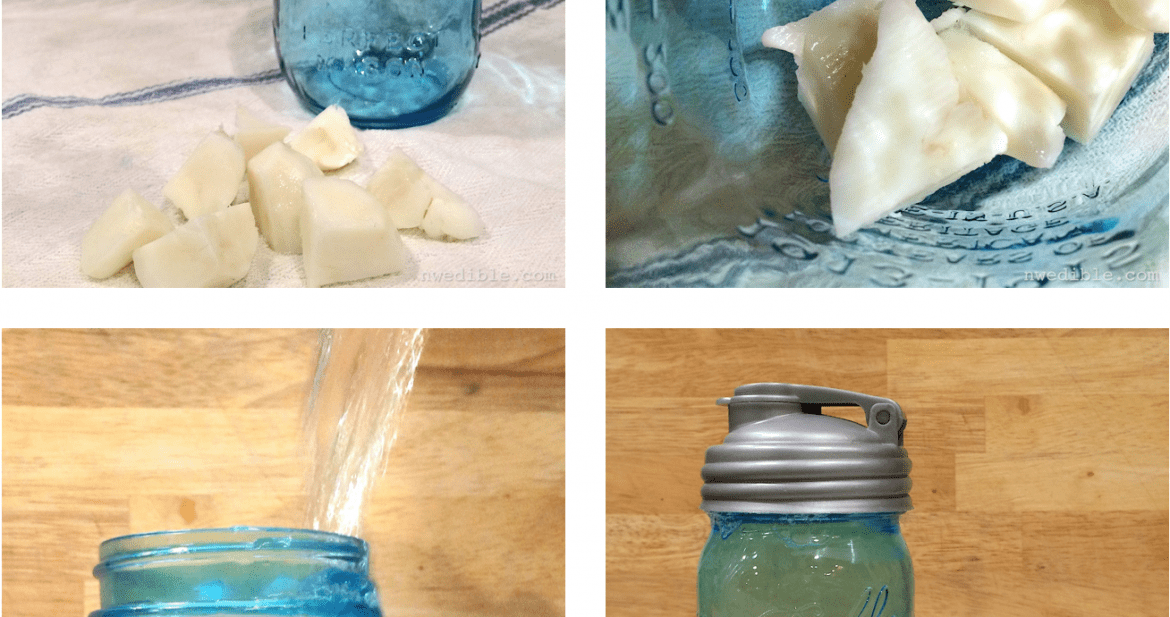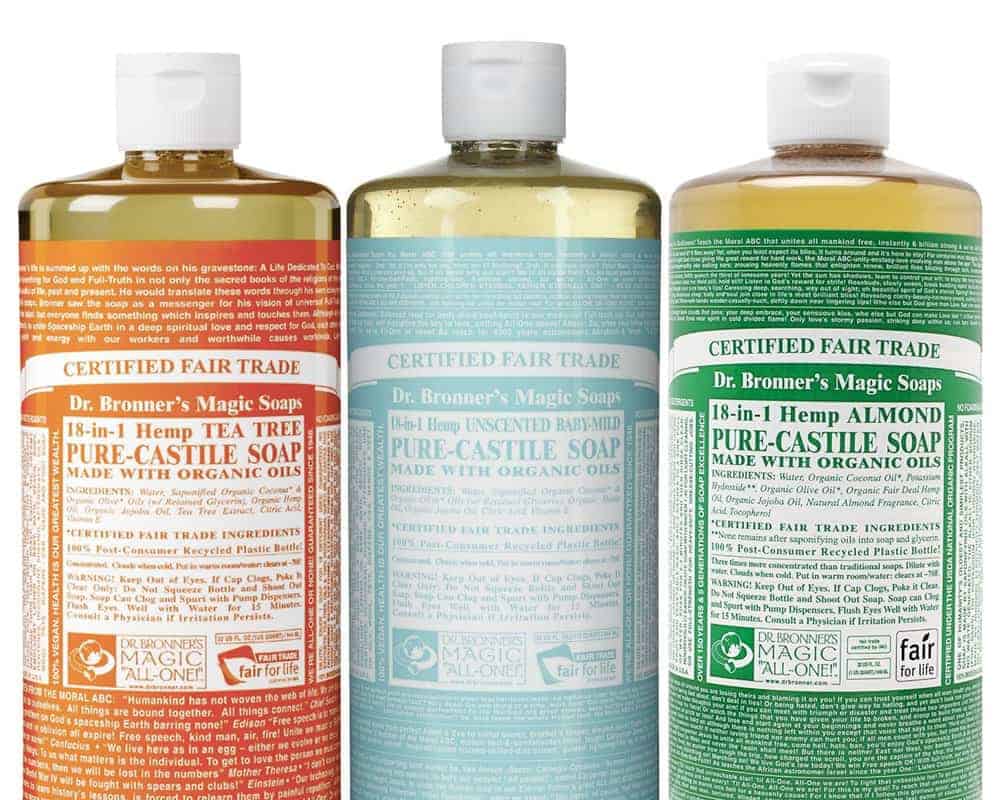When I was recipe testing for the book I ended up making nine or ten batches of cold process bar soap. That is a lot of soap for a family of four.
Normally, I use Dr. Bronner’s liquid Castile soap in many of my personal and home care products, but faced with a glut of all natural, homemade bar soap, I thought perhaps I could melt down and dilute the bar soap, thereby turning it into liquid soap.
Spoiler alert: this does not work. At least, not the way you are hoping it will. But, it does lead to a different and highly useful home care product called Soap Jelly.
What is Castile Soap?
All true soap – not petroleum based detergent but real soap – is made when fat is combined with a strong alkali called lye. A process called saponification takes place that chemically changes the original ingredients into this totally new thing we call soap.
In liquid or bar form, castile soap is simply soap made from exclusively vegetable oils. Traditionally, a Castile soap (named after the Castile region of Spain) was made with 100% olive oil. While all-olive oil soaps are still made, most modern Castile-style soaps blend in other vegetable oils, like coconut.
Castile soap is never made with lard, tallow, or other animal-based soap making fats.
A Tale of Two Lyes

Bar soap is made with sodium hydroxide, one type of lye (the drain cleaner on the left), and liquid soap is made with potassium hydroxide, another kind.
These two lyes are different beasts, from a soap making perspective. They saponify differently, are used at different rates, and result in different textured soaps. So, even though both are called lye, sodium hydroxide and potassium hydroxide are not interchangeable in soap recipes.
Sodium hydroxide is typically used as a lye for bar soap because it reacts to produce a hard, opaque, long lasting bar. Often, just a teeny bit less lye than is needed for complete saponification is used in a bar soap formula. This is called super-fatting, and results in a more luxurious and moisturizing bar of soap. It’s also ensures that no raw lye is left behind in the finished bar of soap.
Liquid soap is a bit different. A good liquid soap is clear, so potassium hydroxide is used because it saponifies fats without forming hard, opaque crystals like sodium hydroxide. Potassium hydroxide also tends to give a more bubbly lather, highly desirable in liquid soaps.
Residual oils in a liquid soap lead to a cloudy product, so liquid soap is typically over-alkalized by adding a little more lye than necessary to the mix. This excess lye is neutralized later with something like citric acid.
Liquid Soap Isn’t Just Bar Soap Plus Water
There are many differences between bar soap and liquid soap, including the lye used, the process to make them, how long they have to cure, and how they are blended. The bottom line is, the chemical properties of bar soap are different than the chemical properties of liquid soap.
So, if you attempt to melt a little bit of your homemade bar soap into warm water, the result will not be a smooth, clear, free-flowing liquid soap like you’d get from a Dr. Bronner’s bottle.
This is a soap that wants to be a dense, hard bar. Mix it into a water and it will grudgingly compromise and give you something with a texture somewhere between goopy gel and toddler snot, depending on how much water you force it to deal with.
Soap Jelly
Soap Jelly is the real name for the snot-textured goo you get when you dissolve a bit of your bar soap into water. Sounds gross, but it turns out this stuff is really, really useful.
I keep mine in a mason jar fitted with a reCAP lid at the sink and use it as dish soap. It works beautifully.
How To Make Soap Jelly

Save up the end-bits of those bars of soap that are too small to look nice at the sink or in the shower. When you have several, add enough soap bits to cover the bottom of a mason jar. Exact quantities aren’t that important.
Add hot water to the jar, and lid tightly. I’m partial to reCAPs for this kind of thing.
Let the jar sit overnight, or even for a few days if your chunks of soap are big like mine. Give the jar a little shake periodically. In time, the soap chunks will fully dissolve and the soap jelly will become viscous.
If your soap jelly is thin enough to add to a pump-bottle, you can use it as liquid or foaming hand or shower soap. I keep my jar of soap jelly by the sink and use it for scrubbing and hand-washing dishes.

Is it just like liquid Castile soap? Nope. But it’s a great cleaning agent and making soap jelly means I’m not wasting any of my awesome, natural homemade soap.



Oh Erica. I am grateful for you every post I read. I just snorted tea on my computer when I read your spoiler alert. Thanks for all the HONEST information you provide. I’m not adding soap making projects to my “to do” list once the school year finishes (I love having summers off).
Good for you! It’s so important to know where to best spend your “DIY buck”!
Thank you — this is very helpful. And it explains the snotty result I got when I tried someone else’s recipe for bar-based liquid soap.
I know. Sometimes I wonder if certain writers actually try some of the stuff they recommend before they put it online
I use soap jelly on my area rugs and my car mechanic hubby pants. His fellow gear heads are always impressed.
If it can get mechanic grease out, it must be amazing, right?
Wow, love this. I have no plans to make my own soap, but I love that you can use up the leftover bits of bar soap for washing dishes. I wash a lot of dishes! Money saver; my frugal heart is going pitter-pat!
Right on, Nicole! Waste not, want not, right? Yup, this works just as well with purchased bar soap as well. I haven’t tried it with detergent bars, but if anything you’d probably get less of the “snotty goop” texture and something more similar to straight liquid dish detergent.
I learned to save soap ends as a child in the 1940’s. The bits of soap are placed in a small mesh, draw-string bag. When the bag is stuffed with enough chips (so it’s the size of a full bar), then the bag is used as ‘a bar of soap.’
“Use it up” was one of those things I learned from Depression-era parents while growing up in rural North Carolina.
I have a mesh bag full of soap ends like that at my garden allotment; it hangs on the water pump for after-garden handwashing and on a hook under the cottage eaves to drip-dry. (The soap ends are samples from Lush, so they’re way too smelly to leave inside!) The mesh also helps scrub my hands to get dirt off.
That’s a great idea, but doesn’t the bar soap kinda melt away in the rain? Is it under cover?
And that would be great as an exfoliant, too, with the scrubby bag!
I save my bar soap bits and when there are enough, remake it. I break it into bits into a custard dish, add just a bit of water and let it soak for several days. Then I mix and cook it a few seconds in the microwave, pour it into something for a mold – old small yogurt container or even a small paper cup. Let it cool and there is a very unique, multi-colored, small round bar of soap.
Neat idea, thank you for adding it!
This looks like a terrific idea. So glad you’re back to active blogging — yours is one of the best blogs I’ve read.
Thanks Margie, it’s nice to be back. 🙂
Also useful for when your bar soap doesn’t set up properly. Hurrah! 😀
Oh, that never happens. /sarcasm. 🙂
Your description of the soapy goo/toddler snot is dead on! I recently made liquid face soap from an organic bar soap and as long as you can get over the consistency it’s awesome! I’ve also made liquid hand soap from an olive oil bar and essential oils.. Not quite as snotty as the face soap, and cleans great.
Never thought to use it for dish soap, but that one bar made about half a gallon of liquid soap, so I may need to come up with a few more uses…
In researching for this post I got sidetracked into a huge consumer analysis about what people are buying re: liquid vs. bar soap. Liquid soap is becoming far more popular, BUT it turns out it’s got a way bigger environmental impact than bar soap, and a large part of why is that people just use much more. People use more grams of liquid soap than bar soap when they wash, and your DIY liquid soap shows why: there is A TON of cleaning power in a single bar of soap.
Hey Erica,
I am an avid “Quilter/Fibre Artrist” & receive approx. 24 newsletters daily; that being said, your message is ALWAYS the first opened & is read by our household of 3. We love all your ingenious ideas/solutions & especially your light hearted attitude.
Thank you ever so much for a great Friday Erica.
Thank you so much Barbara, I really appreciate that. I know there are a lot of demands on my reader’s time. I’m so grateful when folks choose to spend a few minutes of their day here.
Perfect timing! I’ve been doing research on Youtube and reading DIY articles on the internet for makin my own liquid soap from bar soap. Most of the articles suggested using a good quality soap like Dr Bronner’s Castille bar soap but never has anyone reported about this being a falure. It’s good to know who you can trust. Thanks Erica.
Calling it like I see it! 😉 In this case, I’d say failure is a relative term. The result is still pretty awesome and useful, but it is not the same texture as a specially-made liquid soap like Dr. Bronners, or a hot-processed liquid soap made with potassium hydroxide. But yeah, soap jelly =/= liquid soap, in my opinion. 🙂
I have been wondering about melting and diluting bar soap to make liquid soap for ages! So many people say it works and it just seemed too good to be true. But if the somewhat different end product is still useful, I may break down and try it. I hear that liquid soap with potassium hydroxide is significantly harder to make than regular cold processed soap, so I am waiting to have a chuck of extra time to try it. Yeah…
Yeah, liquid soap is basically cooked down to a paste and then diluted – it’s a multi-day process, typically. Not hard, per se, but tedious. Cold process bar soap is so quick and easy in comparison.
Hey Erica,
Great article! I do the same thing, but add fine sea salt and a tad more water then blend like crazy. It turns into an awesome mousse/scrub. I finally perfected it (thanks to having a teenage daughter willing to take a shower every time I make something new). The jell was just too snotty for me, and kind of made me queasy (thank god my children are not babies any more hehe!). I was searching articles just to make sure I was not as crazy as I thought I was for even attempting to change one substance to another. Apparently I am not! I have been browsing your blog and quite enjoying it!
Thanks Cathleen!